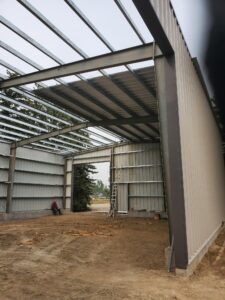Industrial Steel Buildings with Power Steel Buildings: Meeting the Needs of Manufacturers
Industrial steel buildings are structures made primarily from steel, designed to accommodate various industrial activities. These buildings are highly customizable, enabling manufacturers to tailor them to their specific needs. From sprawling factories to compact warehouses, steel buildings offer a versatile and robust solution for a range of industrial applications. In this article, we’ll explore the key advantages of industrial steel buildings and their diverse use cases, demonstrating why they are an ideal choice for modern manufacturers.
Key Advantages of Industrial Steel Buildings
-
Large Spans
One of the most significant advantages of steel buildings is their ability to support large spans without the need for interior columns. This feature is particularly beneficial for manufacturing plants and warehouses, where open space is crucial for the movement of goods, machinery, and personnel. The use of steel allows for the creation of wide, unobstructed areas that can accommodate heavy equipment and facilitate efficient workflow.
-
Cost-Effectiveness
Cost is always a critical consideration in construction. Steel buildings are generally more cost-effective than traditional construction methods. The materials used in steel construction are often less expensive, and the speed of construction further reduces labor costs. Additionally, steel’s durability and low maintenance requirements result in long-term savings, making it an economically sound choice for industrial projects.
-
Quick Construction
Time is money, especially in the manufacturing sector. Steel buildings can be erected much faster than conventional buildings. Prefabricated components are manufactured off-site and then quickly assembled on location. This streamlined process reduces construction time significantly, allowing manufacturers to get their operations up and running sooner. The quicker turnaround also means less disruption to existing operations if the new building is an expansion.
Use Cases for Industrial Steel Buildings
Factories
Factories are perhaps the most common use case for industrial steel buildings. The need for large, open spaces to house machinery, production lines, and storage areas makes steel an ideal material. Steel buildings can be customized to include mezzanines, cranes, and other specialized features that enhance manufacturing efficiency.
Warehouses
Warehouses benefit greatly from the large spans and high ceilings that steel buildings provide. The ability to store goods in a well-organized manner is crucial for inventory management and distribution. Steel buildings can be designed to accommodate racking systems, automated storage and retrieval systems (AS/RS), and other modern warehousing technologies.
Distribution Centers
Distribution centers require durable and adaptable spaces to manage the flow of goods from manufacturers to retailers or end consumers. Steel buildings offer the flexibility needed to create optimized layouts for sorting, packaging, and shipping products. The quick construction time of steel buildings is also beneficial for companies needing to expand their distribution capabilities rapidly.
Conclusion
Industrial steel buildings stand out as a premier solution for meeting the needs of modern manufacturers. Their ability to provide large, unobstructed spaces, coupled with cost-effectiveness and quick construction times, make them an excellent choice for factories, warehouses, and distribution centers. As the manufacturing landscape continues to change, steel buildings offer the flexibility and durability necessary to support growth and innovation in the industry.
Choosing a Power Steel Building for your next project can provide a solid foundation for efficiency and productivity, ensuring that your manufacturing operations can adapt and thrive in an ever-evolving market.


